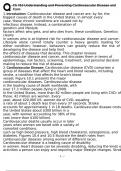Ch #10 Understanding and Preventing Cardiovascular Disease and
Canc
1. Introduction: Cardiovascular disease and cancer are, by far, the
biggest causes of death in the United States. In almost every
case, these chronic conditions are caused not by
infectious disease. Instead, a combination of
genetics and lifestyle
factors affect who gets, and who dies from, these conditions. Genetics
clearly
in uences who is at highest risk for cardiovascular disease and cancer.
Lifestyle alone cannot totally counter a heavy genetic loading for
either condition; however, behaviors can greatly reduce the risk of
developing the disease and help limit
the effects of diseases that develop. This chapter reviews
cardiovascular disease and cancer, and discusses them in terms of
epidemiology, risk factors, screening, treatment, and personal decision
making to reduce the risk of disease.
2. Cardiovascular Disease: Cardiovascular disease (CVD) comprises a
group of diseases that affect the heart and blood vessels, including
stroke, a condition that affects the brain's blood
vessel; Figure 10.1 presents the major
cardiovascular diseases. Cardiovascular disease
is the leading cause of death worldwide, with
over 17.3 million people dying in 2009.
In the United States, more than 82 million people are living with CVD; of
those, 42 million are women. Every
year, about 420,000 US. women die of CVD, equaling
a rate of about 1 death less than every 37 seconds. Stroke
accounts for approximately 1 in 18 deaths. Cardiovascular disease costs
the United States about $300 billion in a
year, with women accounting for 38% of the
cost (more than $100 billion).
Cardiovascular deaths usually occur in later
years when women are beset with a variety of
comorbid conditions,
such as high blood pressure, high blood cholesterol, osteoporosis, and
diabetes. Figures 10.4 and 10.5 illustrate the death rates from
cardiovascular diseases among women of different races.
Cardiovascular disease is a leading cause of disability
in women. Heart disease can be severely disabling, reducing the kinds o
activities a person can enjoy and requiring major lifestyle changes. Strok
, Ch #10 Understanding and Preventing Cardiovascular Disease and
Canc
can lead to paralysis, incontinence, language impairments, and loss of
memory. Heart conditions and stroke are not an inevitable consequence
of aging, but are often related to behaviors such as cigarette smoking,
poor nutrition, lack of exercise, and insuf cient
attention to CVD risk factors such as high blood pressure, high blood
cholesterol, diabetes, and overweight and obesity.
, Ch #10 Understanding and Preventing Cardiovascular Disease and
Canc
3. Epidemiology of Cardiovascular Disease: Cardiovascular disease is the
lead- ing cause of death for
women, regardless of racial or ethnic group. Of the various forms of
CVD, coronary heart disease (CHD), or diseases in which the coronary
arteries that supply blood to the heart become narrowed or blocked, is
the leading cause ofdeath:
Every year, about 190,000 women die from CHD,
slightly less than the number of deaths of men
(216,000). Among
these women, 64% died suddenly with no warning symptoms. Stroke,
the third leading cause of death among women (after heart disease and
cancer), kills about 82,000 (60 women a year, compared with about
54,000 (40 men.
Although some cardiovascular diseases occur
among children and adolescents, they typically
occur among men who are at least 50 years old. The
incidence of CHD begins
to rise for women between the ages of 55 and 60, about 10 years later
than it does for men. The incidence of stroke begins to sharply rise in
both women and men after the age of 60.
4. Economic Dimensions of Cardiovascular Disease: Cardiovascular
disease imposes a heavy burden on the
healthcare system in the United States, particularly on
emergency medical departments and hospitals. Clinical care of CVD
patients is costly and often prolonged.
The estimated cost of cardiovascular disease and
stroke in the United States in 2007 was $286
billion. This gure
includes both direct and indirect costs.
- Direct costs ($167 billion): health expenditures
includ ing those for physicians and other
professionals, hospital and nursing home
services, medications, home health care, and
other medical durables
- Indirect costs ($119 billion): lost productivity
resulting from morbidity and mortality
Cardiovascular disease often affects individuals during
their peak productive years at work, causing signi cant disruption
, Ch #10 Understanding and Preventing Cardiovascular Disease and
Canc
to families who depend on the person's income. The high rate of CVD
also in uences the national
economy by killing or disabling otherwise productive workers. In
addition, the emo- tional cost to women and their families and friends
from such disease is incalculable.
5. Global Dimensions of Cardiovascular Disease: Over the past century,
cardio- vascular disease has surpassed infectious diseases to become
the leading cause of death and disability. With an ever—increasing life
expectancy, countries that once




